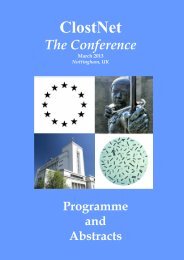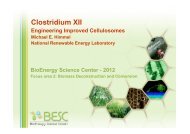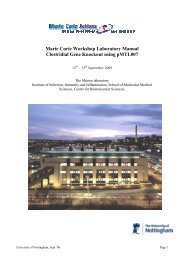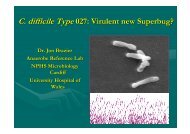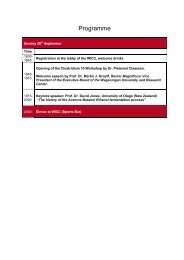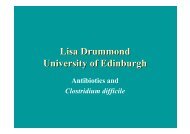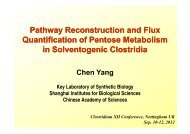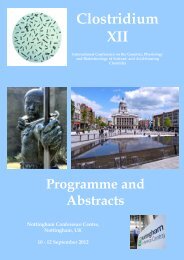abstract book - Clostridia
abstract book - Clostridia
abstract book - Clostridia
Create successful ePaper yourself
Turn your PDF publications into a flip-book with our unique Google optimized e-Paper software.
IMPROVED DIAGNOSIS OF INFANT BOTULISM BY REAL TIME<br />
PCR OF NEUROTOXIN GENES<br />
K. A. Grant, I. Nwafor, C. Curson, O. Mpamugu, V. Mithani and<br />
J. Mclauchlin<br />
HPA Centre for Infections, 61 Colindale Ave, London, NW9 5EQ, UK<br />
(kathie.grant@hap.org.uk)<br />
Infant botulism is a rare disease caused by growth and toxin production<br />
of the bacterium Clostridium botulinum in the enteric tract of infants,<br />
usually less than 12 months of age. Up until 2007 there had only been<br />
6 reported cases of infant botulism in the UK. Diagnosis of infant<br />
botulism is established by demonstrating botulinum neurotoxin and/or<br />
BoNT producing organisms in a faecal specimen. The mouse bioassay<br />
is the gold standard method for detecting BoNT in clinical and food<br />
samples. The assay is highly sensitive but usually takes several days to<br />
perform; is costly; involves the use of live animals and is usually run<br />
without controls. In the UK Reference Laboratory real time PCR assays<br />
for neurotoxin genes are used to assist in the rapid detection and<br />
identification of C. botulinum in cases of wound and food botulism.<br />
Here we describe the use of these assays to detect BoNT A,B,E and F<br />
genes, to assist in the laboratory diagnosis of two unrelated cases of<br />
infant botulism that occurred within two weeks of one another in the<br />
latter half of 2007. In October 2007, samples from two infants (aged 4<br />
and 8 months) with suspect botulism at different hospitals in London<br />
were received by the Reference Laboratory. Following a series of<br />
conventional and PCR based tests the diagnosis of infant botulism was<br />
confirmed. The cases were sporadic and apparently unrelated, with<br />
one found to be due to type A and the second to type B.<br />
These assays used in conjunction with the MBA improved the rapidity<br />
of diagnosis and enabled the real time monitoring of the organism in the<br />
infant gut. Food and environmental samples were rapidly screened by<br />
PCR for the presence of C. botulinum thus improving disease<br />
investigation. The use of real time PCR assays for the detection of<br />
BoNT genes has substantially improved the diagnostic process for<br />
infant botulism facilitating rapid and appropriate patient management.<br />
31



